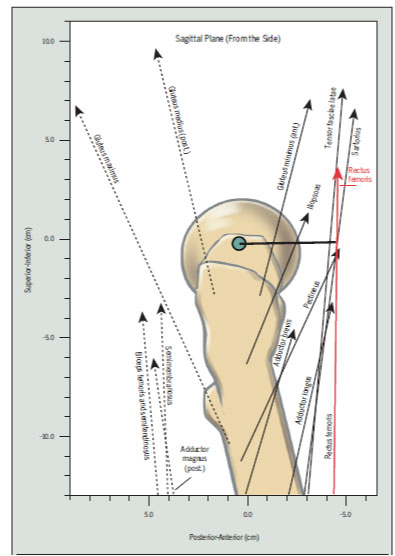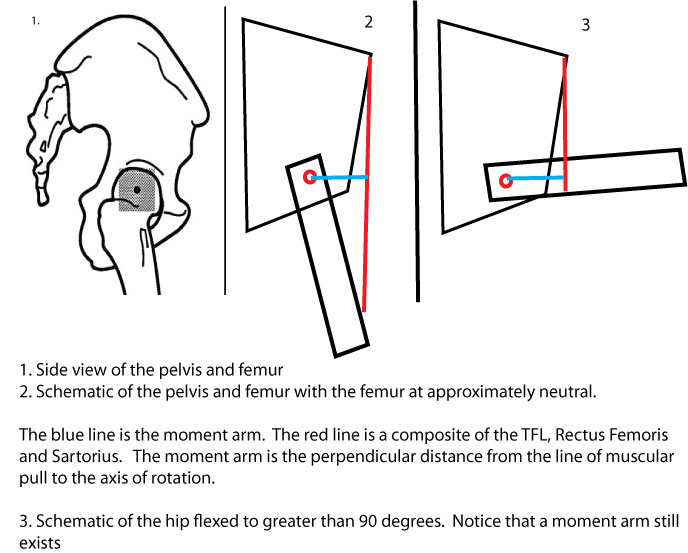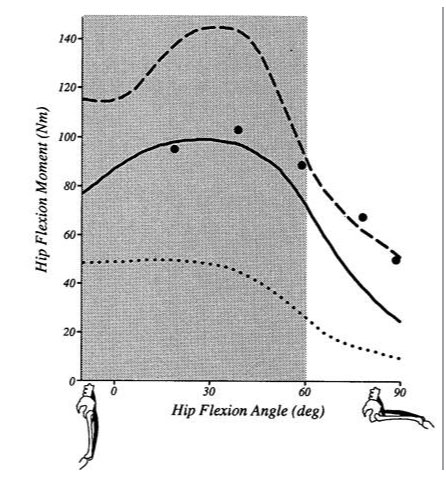Audience: Therapists and strength coaches
Purpose: Questioning a common belief with the use of simple joint mechanics and anatomy.
Caveat of Ignorance: This post is probably one that is more about splitting hairs and quibbling about small details than saying anything ground breaking. This post is unlikely to change your training routines, assessments or rehab protocols. Ideally, it sheds some information on how we explain what we do.
Background: The importance of the hip flexors
I am a big fan of the hip flexors. My first blog post ever was about a Juker and McGill paper that looked at psoas function and one of my favourite posts that I have written highlights how the transition from slowish running to really running fast correlates with changes in hip flexor power and increases in hip flexion. I often describe running (post here on insights into hip flexor function) as more of a “pulling” motion with the hip flexors (and the glutes pulling the leg back and down) than a motion of pushing off (i.e. the extensor paradox - where the extensors actually shut off during mid stance of running. See these posts for a quick review here and here).
The only hip flexors above 90 degrees of flexion are the Psoas and Illiacus?
This idea has been written about a great deal (here and here for good reviews and then good explanations of how to train and test hip flexor function) but I believe the idea originally came from Shirley Sahrmann. The idea is that after 90 degrees of hip flexion the TFL, Sartorius and Rectus Femoris are unable to exert a flexor moment because the distal insertion is essentially above the proximal insertion of these muscles on the iliac crest and all mechanical advantage is lost.
I took Dr. Sahrmann’s course and actually spoke to her a little bit about this idea. Paraphrasing she suggested the TFL, Sartorius and Rec Fem at above 90 degrees of flexion do not have a moment arm and therefore can not cause any rotation of the femur in the acetabulum, therefore no more flexion. Remember, the moment arm is the perpendicular distance from the muscles line of pull and the joint centre of rotation. The greater the moment arm the greater the leverage. You have no moment arm if your line of pull passes through the centre of rotation. You can’t create any torque with this force application.
Below is a picture of the lines of force of each hip muscle and you can also see their moment arms. The picture is from Neumann (JOSPT 2009).
If the theory is true it is valuable because it gives us a means to test the Psoas and Iliacus separate from the other hip flexors. This would be fantastic because you can now isolate these muscles from their synergists and determine if they are weak or dysfunctional in their own right. This would be lovely. Unfortunately, I can’t figure out how it works and therefore question its validity. I suck.
My concerns with the theory
This explanation about loss of mechanical advantage never made sense to me…i could never picture it or recreate it with a model. I used to take my spine and hip model and try to figure it out with little elastic bands, scribble on napkins my little drawings but I could not quite grasp it. Because there was nothing to grasp. When I drew a schematic of the hip at 90 degrees there was always a moment arm for the TFL, Sartorius and Rectus Femoris. It does not matter if the distal insertion is now above the proximal insertion. You can still pull the leg toward your belly.
Imagine standing at one end of 20 foot two by four with a rope in your hand. Now imagine the rope is tied to the other end of the two by four. If you fix the two by four with your feet you can pull the two by four up to an upright position. You did this despite the distal insertion being above your hands. However, if you were lying on your belly and pulled the end of the rope parallel to the two by four and at no distance from the two by four’s axis of rotation than you would have no torque…but this is not how hip flexion works.
I drew this analogy to Dr Sahrmann. She said some of her biomechanics people would get back to me. Not yet.
Below is another schematic that helps illustrate this with the hip flexed to ninety degrees. The blue line is the moment arm. The red line is the muscles line of pull. Notice how the muscles line of pull is still at a distance from the joint centre. This means we can still have torque.
OK. So what?
Good question. We are weak at 90 degrees of hip flexion. This is undeniable. Below is a graph depicting changes in hip flexion strength with changes in hip flexion (Scott Delp 1993 - He is a great biomechanist/functional anatomist and his free papers are here). It also shows what happens if the hip centre of rotation is displaced superiorly or inferiorly. Notice you have greater force production with an inferior displacement.
So, what is my point?
My point is that the psoas and iliacus are not the only functioning hip flexors above ninety degrees and our tests that we think are just testing the Psoas/iliacus are probably not doing that. However, I don’t doubt that the TFL and Sartorius may be extremely shortened at this amount of hip flexion and therefore would not be very effective in producing force…this is probably why many feel cramping in this muscle during this test. I just don’t have any data on this, can’t quantify it and only consider it a possibility. But we can’t use this argument for the Rectus Femoris. It still has a moment arm at 90 degrees of hip flexion and it is biarticular. If the knee is flexed then it would not be incredibly shortened when we just flex the hip and this super shortened equaling weakness at the hip does not hold.
Again, so what really is your point? How is this relevant?
That’s it. No more point. Not a big deal. Sorry.
I would argue that you still use the high hip flexion test as a measure of function at this range of movement. We can’t ascribe a deficit to any one muscle but who cares. We can still see if the person is weak or the movement sucks. Thats why all the posts out there that discuss psoas function and hip flexor strength are still useful. I’ve just simplified things for everyone. Train your hip flexors at all ranges god damn it.
Again here are some links on testing and training high hip flexion.
1. Mike Reinolds stuff on assessment and training: http://www.mikereinold.com/2011/10/functional-assessment-and-exercises-to-enhance-hip-flexion.html
2. Chris Johnson on the importance of hip flexion strength on Mike Reinolds Blog:
http://www.mikereinold.com/2011/10/the-importance-of-hip-flexion-strength.html
3. Mike Boyle’s piece imploring us to think and understand the importance of hip flexion
http://www.personaltrainertoday.com/understanding-hip-flexion-cec
4. David Laisners post about hip flexion over ninety
http://davidlasnier.com/tag/hip-flexion-above-90-degrees
5. Andrew Paul’s the Hip Flexor Solution with lots of pictures
http://www.elitefts.com/documents/hip_flexor.htm
Obviously, if you read some of these posts you will see that I disagree with some of the ideas but the disagreement pertains to explaining the rationale for what we see when testing and training. This disagreement does not negate all the good and useful information in these posts.
What is this blog post missing
I talk nothing about “quality” of movement and what muscles we might want flexing the hip. Many of the posts above get into this concept and provide excellent descriptions although the research substantially supporting the ideas has not been done. However, mathematical models looking at an assumed ideal recruitment pattern has occurred. This modelling was done by a former PhD student of Dr. Sahrman’s, Cara Lewis. She suggests that Psoas/Iliacus activation is better for labral health as the activation of the Psoas will create a posterior shear to the anterior hip thus creating less Labral Stress. This may be important for FAI, labral tears and anterior femoral glide. I wrote about Cara’s research in this post here: I think her stuff is great but we still need more work done. (as usual)
All the best,
Greg







Awesome Greg! I can really relate to the way you think. I’ve questioned this myself and have read much of the same research as you. I appreciate your posts!